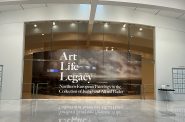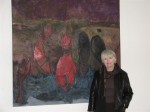Time Machine
Three days after listening to Russell Bowman’s lecture at the Milwaukee Art Museum, I drove with a friend to re-visit the John Michael Kohler Arts Center (JMKAC) in Sheboygan. Bowman, the former Executive Director of MAM, spoke so eloquently and in-depth about when and how MAM’s “folk art” collection came to fruition; it seemed the perfect excuse to take another look at JMKAC’s collection of art, specifically Sublime Spaces & Visionary Worlds: Built Environments of Vernacular Art, which runs until January 2008.
Let’s forget about labels for the time being. Whether you choose to refer to work produced by self-taught artists as “folk,” “outsider,” or “visionary,” bear in mind that the distinctions overlap more often than they divide. Blurred boundaries can be a good thing.
Walking through the galleries is somewhat akin to entering a voluminous tent where a circus is underway. Step right up, folks. Don’t be afraid. What you are about to see is not an illusion.
With twenty-one artists represented, artists from here, there, and everywhere, you’d expect to feel claustrophobic, because many of the artists produced massive figurative works originally intended for “natural” environments such as yards and wide open spaces. Thanks to the excellence of JMKAC’s curatorial staff, though, each artist’s work clearly has its own space and never seems isolated. Nothing is crowded or crammed awkwardly. The interior architecture embraces the collection. Intricate, concrete constructions lead to stately clusters of figures fashioned from fabrics and clay before giving way to the light and airy wire fantasies of the wildly prolific Emery Blagdon. Standing there, I wondered what it might be like to live inside of a delicate web spun by the mind of an artist. My friend remarked that she wished there was a fan blowing nearby, so she could see the slender objects move. When we looked skyward to pieces suspended from the ceiling, indeed, some were moving, but ever so gently, in the whispering air currents. A fan would have been a travesty!
In his lecture, Russell Bowman remarked that sometimes when the work of self-taught artists is removed from its natural environment to an institutionalized setting, it acquires another meaning. I agree with his statement, but such is not the case with this outstanding exhibit, which avoids being “precious.” At the risk of sentimentalizing the entire experience, it did seem that the artists themselves were present, so powerful is the work. The text panels were highly informative (and interspersed with video moments here and there), but had there been no information, the exhibit would be no less powerful.
The late Mary Nohl, whose generosity funds the prestigious Mary Nohl Fellowship, has a room to herself. Her craftsmanship is perfect, and though many of her pieces are highly derivative (as is the case with two wall-hung wooden constructions in the style of Louise Nevelson), the range of her efforts (metalsmith-ing, painting, ceramics, wood carving) illuminate a mind intent on exploring the many forms of art making. Her work is modest and concentrated on the “making of objects,” rather than the objects per se. Jilan remarked that she has several of Nohl’s small ceramic pieces in her Milwaukee home. She found them while cleaning out boxes in the basement of the Walker’s Point Center for the Arts; given the go-ahead to keep what she found, she rescued the articles from oblivion, and uses them on a daily basis. I’d like to think Ms. Nohl would be pleased.
Is there any work more intriguing than that of Eugene Von Bruenchenhein, the West Allis artist who must have (with his wife) eaten his way through mountains of chicken, the bones of which he recycled into elegant towers and tiny chairs? When Bowman initially saw this man’s paintings, he said, he didn’t know quite what to make of them. And is it any wonder? The paintings are garish with many depictions of hellish atomic bombs. Bowman later visited Bruenchenhein’s home, filled to the brim with chicken bone sculptures and peculiar crowns the artist made for his queenly wife. It was there he saw multiple photographs of Bruenchenhein’s spouse, posed (clad and unclad) in a cheesy pin-up style reminiscent of the 1940s. JMKAC pulls it together, and it’s not hard to imagine you are standing in the original house surrounded by kinky, quirky and wonderful stuff. Chicken bones and crowns and sex have never looked so swell!
These questions are best left to academics and marketing departments whose job it is to explore possibilities. By any measure, this exhibit is major. For a preview, go to jmkac.org. VS
Sublime Spaces & Visionary Worlds: Built Environments of Vernacular Art will be at the John Michael Kohler Arts Center in Sheboygan through January 2008. A major 2007 Princeton Architectural Press publication details the exhibition. For anyone interested in pursuing the development of the Kohler Foundation and the subsequent growth of the collection at the John Michael Kohler Arts Center, 423 pages may seem not quite enough. The book is as heavy as a piece of concrete, but the writing is both light-hearted and scholarly, a treasure trove of information (including outstanding photographs). Like the collection it describes, the publication is itself a work of art straight from the heart and minds of various contributors and the result of years of concentrated effort. Some might be satisfied with a $65 dazzling hardcopy book used primarily to impress their friends. Pity them, for one has only to read Ruth DeYoung Kohler’s sensitive introduction to understand thoroughly that “the need to personalize our homes is a defining human characteristic.” Buy, beg, or borrow this book and use it often as a guide to what it means to be dedicated and determined.
Art
-
Exhibit Tells Story of Vietnam War Resistors in the Military
 Mar 29th, 2024 by Bill Christofferson
Mar 29th, 2024 by Bill Christofferson
-
See Art Museum’s New Exhibit, ‘Portrait of the Collector’
 Sep 28th, 2023 by Sophie Bolich
Sep 28th, 2023 by Sophie Bolich
-
100 Years Of Memorable Photography
 Sep 18th, 2023 by Rose Balistreri
Sep 18th, 2023 by Rose Balistreri
















